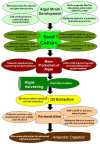Electromagnetic biostimulation of living cultures for biotechnology, biofuel and bioenergy applications
- PMID: 20057958
- PMCID: PMC2790121
- DOI: 10.3390/ijms10104515
Electromagnetic biostimulation of living cultures for biotechnology, biofuel and bioenergy applications
Erratum in
- Int J Mol Sci. 2009 Nov;10(11):4719-22
Abstract
The surge of interest in bioenergy has been marked with increasing efforts in research and development to identify new sources of biomass and to incorporate cutting-edge biotechnology to improve efficiency and increase yields. It is evident that various microorganisms will play an integral role in the development of this newly emerging industry, such as yeast for ethanol and Escherichia coli for fine chemical fermentation. However, it appears that microalgae have become the most promising prospect for biomass production due to their ability to grow fast, produce large quantities of lipids, carbohydrates and proteins, thrive in poor quality waters, sequester and recycle carbon dioxide from industrial flue gases and remove pollutants from industrial, agricultural and municipal wastewaters. In an attempt to better understand and manipulate microorganisms for optimum production capacity, many researchers have investigated alternative methods for stimulating their growth and metabolic behavior. One such novel approach is the use of electromagnetic fields for the stimulation of growth and metabolic cascades and controlling biochemical pathways. An effort has been made in this review to consolidate the information on the current status of biostimulation research to enhance microbial growth and metabolism using electromagnetic fields. It summarizes information on the biostimulatory effects on growth and other biological processes to obtain insight regarding factors and dosages that lead to the stimulation and also what kind of processes have been reportedly affected. Diverse mechanistic theories and explanations for biological effects of electromagnetic fields on intra and extracellular environment have been discussed. The foundations of biophysical interactions such as bioelectromagnetic and biophotonic communication and organization within living systems are expounded with special consideration for spatiotemporal aspects of electromagnetic topology, leading to the potential of multipolar electromagnetic systems. The future direction for the use of biostimulation using bioelectromagnetic, biophotonic and electrochemical methods have been proposed for biotechnology industries in general with emphasis on an holistic biofuel system encompassing production of algal biomass, its processing and conversion to biofuel.
Keywords: algae; bioenergy; biofuels; biomass; biostimulation; electromagnetic field; growth; metabolism; multipolar.
Figures





Cell Membrane
- Magnetic field oscillations may increase membrane permeability under ion cyclotron resonance
- Increased circulation and selective enhancement of ion flow may affect the rate of biochemical reactions
- Alter the rate of binding of calcium ions to enzymes or receptor sites
- Change distribution of protein and lipid domains, and conformational changes in lipid-protein associations
- Change internal molecular distribution of electronic charge inside lipid molecule in the membrane bilayer
- May play the primary role in the stochastic resonance amplification process
Chloroplast
- May modulate the quantity of pigments, such as chlorophyll, phycocyanin, and beta-carotene
Nucleus/DNA
- Magnetic field affects specific gene expression
- Individual DNA sequences may function as antennae
- Leads to changes in DNA conformation
- May activate different DNA sequences depending on field intensity
- Can affect enzyme activity
Proteins:
- Breathing motions are the source and receiver of multipole EMF
- Potential coupling mechanism for external multipolar influences
Protoplasm
- Static magnetic fields influence the speed of protoplasm movement, miotic activity, and quantity of organic acids in plants
Whole Cell
- Biophotonic emission and interaction with nearby cells
- Endogenous electric field modulation may alter natural processes


Similar articles
-
Integration of microalgae cultivation with industrial waste remediation for biofuel and bioenergy production: opportunities and limitations.Photosynth Res. 2011 Sep;109(1-3):231-47. doi: 10.1007/s11120-011-9638-0. Epub 2011 Mar 9. Photosynth Res. 2011. PMID: 21461850 Review.
-
Theoretical Calculations on the Feasibility of Microalgal Biofuels: Utilization of Marine Resources Could Help Realizing the Potential of Microalgae.Biotechnol J. 2016 Nov;11(11):1461-1470. doi: 10.1002/biot.201600041. Biotechnol J. 2016. PMID: 27782372 Free PMC article.
-
A Holistic Approach to Managing Microalgae for Biofuel Applications.Int J Mol Sci. 2017 Jan 22;18(1):215. doi: 10.3390/ijms18010215. Int J Mol Sci. 2017. PMID: 28117737 Free PMC article. Review.
-
Current Scenario and Global Perspective of Sustainable Algal Biofuel Production.Recent Pat Biotechnol. 2025;19(4):276-300. doi: 10.2174/0118722083322399240927051315. Recent Pat Biotechnol. 2025. PMID: 39390829 Review.
-
Microalgal lipids biochemistry and biotechnological perspectives.Biotechnol Adv. 2014 Dec;32(8):1476-93. doi: 10.1016/j.biotechadv.2014.10.003. Epub 2014 Oct 14. Biotechnol Adv. 2014. PMID: 25449285 Review.
Cited by
-
Biogenic zinc oxide nanoregulator determines the quantitative analysis of morpho-anatomical and antioxidant capacity in Lactuca sativa L.Food Sci Nutr. 2024 Aug 18;12(10):7954-7967. doi: 10.1002/fsn3.4261. eCollection 2024 Oct. Food Sci Nutr. 2024. PMID: 39479692 Free PMC article.
-
Magnetic fields as inducer of glutathione and peroxidase production by Saccharomyces cerevisiae.Braz J Microbiol. 2022 Dec;53(4):1881-1891. doi: 10.1007/s42770-022-00836-9. Epub 2022 Oct 6. Braz J Microbiol. 2022. PMID: 36199005 Free PMC article.
-
Magnetic-dependent ATP pool in Escherichia coli.Dokl Biochem Biophys. 2017 May;474(1):196-199. doi: 10.1134/S1607672917030085. Epub 2017 Jul 20. Dokl Biochem Biophys. 2017. PMID: 28726098
-
Magnetic treatment of microalgae for enhanced product formation.World J Microbiol Biotechnol. 2017 Aug 22;33(9):169. doi: 10.1007/s11274-017-2332-4. World J Microbiol Biotechnol. 2017. PMID: 28831658 Review.
-
Effects of electrical biostimulation and silver ions on porcine fibroblast cells.PLoS One. 2021 Feb 10;16(2):e0246847. doi: 10.1371/journal.pone.0246847. eCollection 2021. PLoS One. 2021. PMID: 33566869 Free PMC article.
References
-
- Pilla AA, Markov MS. Bioeffects of weak electromagnetic fields. Rev Environ Health. 1994;10:155–169. - PubMed
-
- Velizarov S. Electric and magnetic fields in microbial biotechnology: Possiblities, limitations, and perspectives. Electro- Magnetobiol. 1999;18:185–212.
-
- Chisti Y. Biodiesel from microalgae. Biotechnol. Adv. 2007;25:294–306. - PubMed
-
- Rai S. Causes and mechanism(s) of ner bioeffects. Electromagn. Biol. Med. 1997;16:59–67.
-
- Banik S, Bandyopadhyay S, Ganguly S, Dan D. Effect of microwave irradiated Methanosarcina barkeri DSM-804 on biomethanation. Bioresour. Technol. 2005;97:819–823. - PubMed
Publication types
MeSH terms
Substances
LinkOut - more resources
Full Text Sources
Other Literature Sources
Molecular Biology Databases

